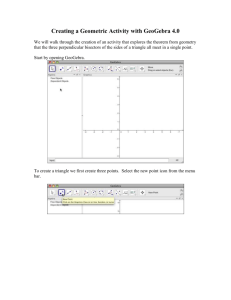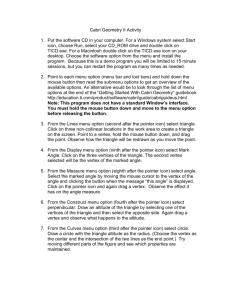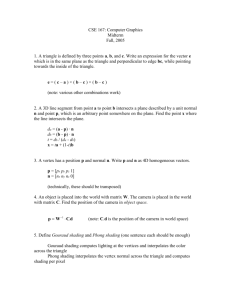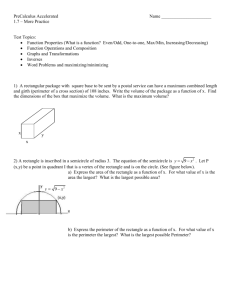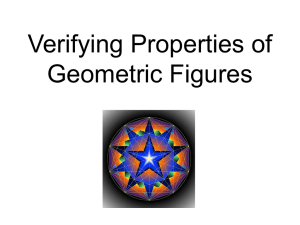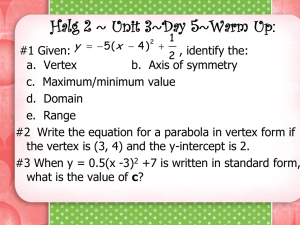A polygon is inscribed in a circle when all the vertices of the polygon
advertisement
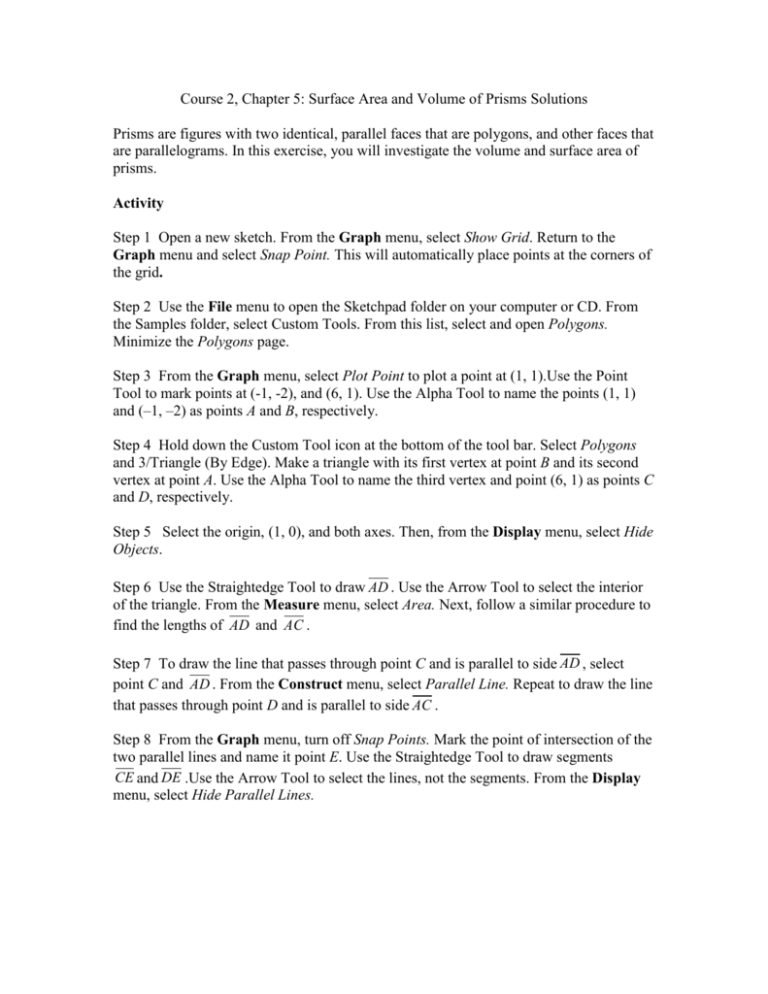
Course 2, Chapter 5: Surface Area and Volume of Prisms Solutions Prisms are figures with two identical, parallel faces that are polygons, and other faces that are parallelograms. In this exercise, you will investigate the volume and surface area of prisms. Activity Step 1 Open a new sketch. From the Graph menu, select Show Grid. Return to the Graph menu and select Snap Point. This will automatically place points at the corners of the grid. Step 2 Use the File menu to open the Sketchpad folder on your computer or CD. From the Samples folder, select Custom Tools. From this list, select and open Polygons. Minimize the Polygons page. Step 3 From the Graph menu, select Plot Point to plot a point at (1, 1).Use the Point Tool to mark points at (-1, -2), and (6, 1). Use the Alpha Tool to name the points (1, 1) and (–1, –2) as points A and B, respectively. Step 4 Hold down the Custom Tool icon at the bottom of the tool bar. Select Polygons and 3/Triangle (By Edge). Make a triangle with its first vertex at point B and its second vertex at point A. Use the Alpha Tool to name the third vertex and point (6, 1) as points C and D, respectively. Step 5 Select the origin, (1, 0), and both axes. Then, from the Display menu, select Hide Objects. Step 6 Use the Straightedge Tool to draw AD . Use the Arrow Tool to select the interior of the triangle. From the Measure menu, select Area. Next, follow a similar procedure to find the lengths of AD and AC . Step 7 To draw the line that passes through point C and is parallel to side AD , select point C and AD . From the Construct menu, select Parallel Line. Repeat to draw the line that passes through point D and is parallel to side AC . Step 8 From the Graph menu, turn off Snap Points. Mark the point of intersection of the two parallel lines and name it point E. Use the Straightedge Tool to draw segments CE and DE .Use the Arrow Tool to select the lines, not the segments. From the Display menu, select Hide Parallel Lines. Step 9 To draw a triangle congruent to the first, return to the Custom Tools icon and select Polygons and 3/Triangle (By Edge). Use point D for the first vertex and point E for the second vertex. Draw a line segment connecting point B to the third vertex of the new triangle. Name the third vertex point F. Turn Snap Points back on before the next step. Step 10 In order, select points A, C, E, and D. From the Construct menu, select Quadrilateral Interior and, from the Display menu, select Color. Choose a different color. Repeat for points A, B, F, and D. Step 11 From the File menu, select Document Options. From the drop-down Add Page menu, select Blank Page. On the new page, repeat Steps 1 and 3. Use Polygons to make a 4/Square (By Edge) starting with point B and with a second vertex at A. Name the third (lowest) vertex of the square, the fourth vertex, and point (6, 1) as points C, D and E, respectively. Draw AE . Step 12 Use the Arrow Tool to select the interior of the square and find its area. Measure the lengths of AB and AE . Step 13 Draw the line that passes through point E and is parallel to side AD . Draw the line that passes through point D and is parallel to AE . Name the point of intersection of these two parallel lines point F. Draw line segments EF and DF . Hide the parallel lines. Step 14 Draw a square, using point E for the first vertex and point F for the second vertex. If you wish, drag E closer to F. Draw the remaining two lines segments needed to complete the prism. Construct the remaining three quadrilateral interiors, making each interior a different color. Step 15 Create a new page and repeat the process using a pentagon. Be sure that the first two points are at the corners of the grid and, from the Graph menu, turn off Snap Points. (Draw and measure line segment, make polygonal region and find area, draw parallel lines and draw line segments. Draw new polygon, and define rectangular regions.) Turn Snap Points back on at the end of this step. Analyze the Results You have made two-dimensional representations of three-dimensional figures. As you drag points, the areas of the original figures and the lengths of the original line segments will be accurate, but the other parts of the figures will be distorted. On page 1, drag point D so that AD is one centimeter long. 1a.What is the area of the triangle? Areas will vary depending on sketch. 1b. If you could arrange one-centimeter cubes on the triangle so that they exactly fit, how many cubes would there be? Same as answer for Question 1a Drag point D so that AD is two units long. 2a. How many layers of one-inch cubes would there be? 2 2b. How many total cubes would there be? Twice as many as answer to Question 1b 3. From the Measure menu, select Calculate. Click on the area of the triangle and the length of AD . Click OK. Drag point B and watch as the calculation values change. What geometric measure does the calculation represent? Volume 4. On pages 2 and 3, repeat Questions 1-3. How do you find the volume of a prism? Possible answer: The volume of a prism is the area of the base times the height. 5. Return to page 1. Use an expression to calculate the area of one of the rectangles. What expression did you use? What is the area? The area is the length times the width. Possible expression: AB times AD ; area measures will vary depending on sketch. 6a. How many congruent triangles and how many congruent rectangles are in the figure? 6b. Write an expression representing the total area, using t for the area of each triangle and r for the area of each rectangle. What geometric measure does this represent? 6c. Calculate to find the surface area of the figure. What expression did you enter? Drag point B and watch the calculated value change. 6a. 2 triangles and 3 rectangles 6b. 2t + 3r; surface area 6c. 2 times the area of the triangle + 3 times the area of the rectangle 7. Investigate the surface areas for the figures on pages 2 and 3. How can you find the surface area of a prism? The rectangular prism has 2 squares and 4 rectangles; the pentagonal prism has 2 pentagons and 5 rectangles. The surface area of a prism is 2 times the area of the base + the number of sides of the polygon times the area of a rectangle.
